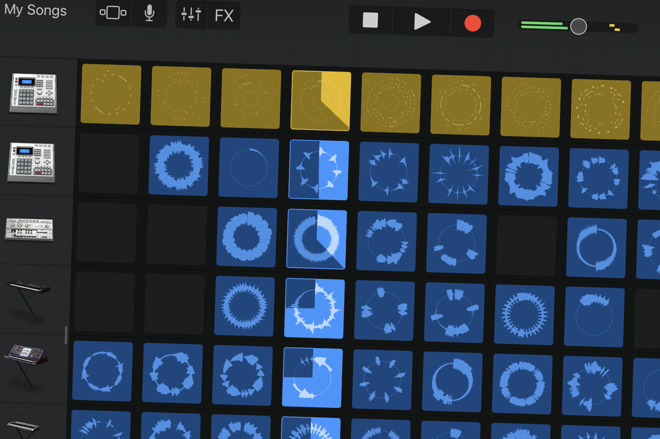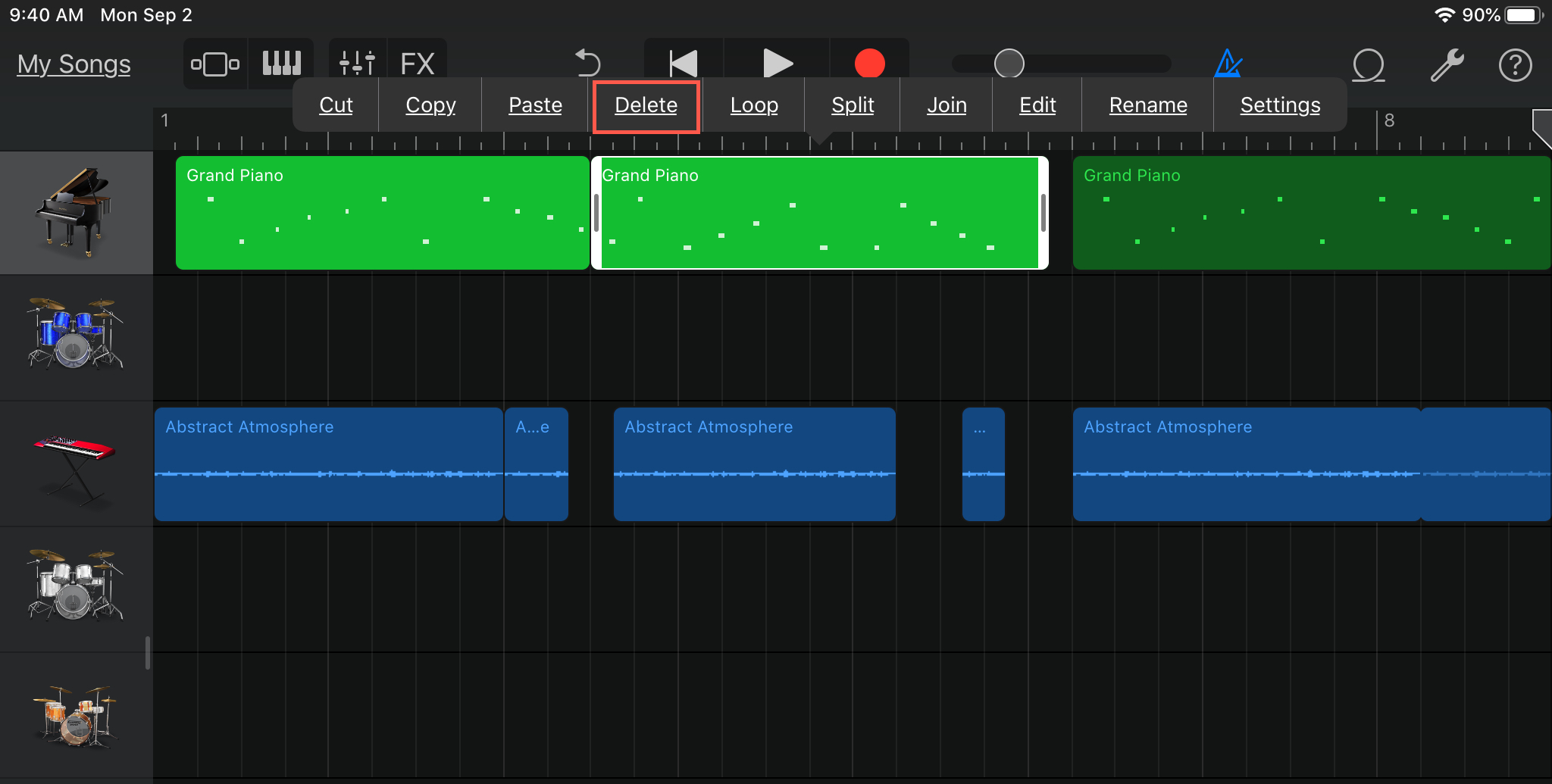How To Delete Tracks On Garageband Mac
- How Do You Delete Tracks On Garageband
- How To Install Garageband On Mac
- How To Delete Tracks On Garageband Mac Download
- Delete Garageband From Mac
Using your MacBook, you can add loops to an empty track in GarageBand to build your song. You do that by listening to loops and making selections from the Loop Browser — Apple provides you with thousands of loops to choose from, along with more you can buy — and photos from your Media Browser. Click the Loop Browser button (which bears the loop symbol) to display your collection.
Look for the right loop
The track in this running example uses a Rock drum kit, but you haven’t added a loop yet. Follow these steps to search through your loop library for just the right rhythm:
Click the button that corresponds to the instrument you’re using.
Click the Kits button in the Loop Browser, and a list of different beats appears in the pane at the bottom of the Loop Browser window.
Click one of the loops with a green musical-note icon.
Go ahead; this is where things get fun! GarageBand begins playing the loop nonstop, allowing you to get a feel for how that particular loop sounds.
When you use only software instruments in a track, choose only software instrument loops, which are identified by a green musical-note icon.
Click another entry in the list, and the application switches immediately to that loop.
Garageband world music jam pack download. Now you’re beginning to understand why GarageBand is so cool for both musicians and the note-impaired. It’s like having your own band, with members who never get tired and who play whatever you want while you’re composing. (Mozart would’ve loved this.)
If you want to search for a particular instrument, click the Search box and type the text you want to match. GarageBand returns the search results in the list.
Scroll down the list and continue to sample the different loops until you find one that fits like a glove.
For this reporter, it’s Southern Rock Drums 01.
Drag the entry to your Rock Kit track and drop it at the very beginning of the timeline (as indicated by the playhead).
If you want that same beat throughout the song, you don’t need to add any more loops to that track. However, if you want the drum’s beat to change later in the song, you would add a second loop after the first one in the same track. For now, leave this track as is.
Mastering GarageBand on your Mac is much about getting comfortable with tracks and loops. Most musical compositions consist of several tracks, or layers of individual parts recorded by different instruments. You can connect instruments to your Mac or you can take advantage of numerous digitally sampled software instruments, heard as you play one of the. Video Guide: How to Uninstall Garageband using App Cleaner. Now let’s see step by step guide of GarageBand removal: Download App Cleaner & Uninstaller and scan your Application folder. Then select Garageband and click the Remove or Uninstall button. Confirm the removal. Nov 22, 2017 GarageBand's Live Loops let anyone make amazing tracks. Photo: Charlie Sorrel/Cult of Mac Today we’re going to figure out how to use GarageBand’s Live Loops feature.
Whoops! Did you do something that you regret? Don’t forget that you can undo most actions in GarageBand by pressing the old standby — cmd+Z — immediately afterward.
When you compose, you can add tracks for each instrument that you want in your song:

Each track can have more than one loop.
Loops don’t have to start at the beginning; you can drop a loop anywhere in the timeline.
You put loops on separate tracks so that they can play simultaneously on different instruments. If all your loops in a song are added on the same track, you hear only one loop at any one time, and all the loops use the same software instrument.
By creating multiple tracks, you give yourself the elbowroom to bring in the entire band at the same time. It’s über-convenient to compose your song when you can see each instrument’s loops and where they fall in the song.
Click the Reset button in the Loop Browser to choose another instrument or genre category.
How Do You Delete Tracks On Garageband
GarageBand includes a Songwriting project you can use to add tracks on your MacBook (also available from the top-level New Project dialog). When you choose the Songwriting project, GarageBand presents you with a full set of four instrument tracks, plus a real instrument track for your voice. You’re instantly ready to start adding loops and recording your own voice!
If you’ve followed along to this point, you’ve noticed two issues with your GarageBand window:
You find no keyboard. You can record the contents of a software instrument track by “playing” the keyboard, clicking the keys by tapping your trackpad. If you’re a musician, the best method of recording your own notes is with a USB MIDI instrument. For now, you can display the keyboard window by pressing cmd+K. If you don’t need it, banish the window by clicking the Close button.
Even if you’re not interested in the point-and-click keyboard, GarageBand offers a musical typing keyboard, where you press the keys on your keyboard to simulate the keys on a musical keyboard. (Hey, if you don’t have a MIDI instrument, at least it’s better than nothing.) To display the musical typing keyboard window, press Shift+cmd+K.
The example song has only one track. If you want to write the next classical masterpiece for Grand Piano, that’s fine. Otherwise, on the GarageBand menu bar, choose Track→Delete Track to start with a clean slate.
You can use the following five kinds of tracks in GarageBand:
Software instrument tracks: These tracks aren’t audio recordings. Rather, they’re mathematically precise algorithms that your laptop renders (or builds) to fit your needs. If you have a MIDI instrument connected to your MacBook, you can create your own software instrument tracks.
Real instrument tracks: A real instrument track is an actual audio recording, such as your voice or a physical instrument without a MIDI connection. (Think microphone.)
Electric Guitar tracks: GarageBand includes a real instrument track, especially made for an electric guitar, that allows you to use one of five different amplifiers and a number of stomp boxes (those effect pedals that guitarists are always poking with their foot to change the sound of their instruments).
Podcast artwork track: You get only one of these; it holds photos that will appear in a video iPod (or a window on your website) when your podcast is playing.
Video tracks: The video sound track appears if you’re scoring (adding music to) an iMovie movie. Along with the video sound track, you get a cool, companion video track that shows the clips in your movie.
How To Install Garageband On Mac
It’s time to add a software instrument track of your very own. Follow these steps:

How To Delete Tracks On Garageband Mac Download
Click the Create a New Track button (which carries a plus sign), labeled.
GarageBand displays the New Track dialog.
Click the Software Instrument radio button, and then click Create.
See all those great instruments in the Track Info pane on the right?
Select the general instrument category by clicking it.
From the right column, choose your specific style of weapon, such as Rock Kit for an arena sound.
Delete Garageband From Mac
If you’re creating a podcast and you want to add a series of still images that will appear on a video iPod’s screen (or on your web page), follow these steps:
Click the View Media Browser button.
Click the Photos button.
GarageBand displays all the photos in your iPhoto Library and events.
Drag an image from your iPhoto Library in the Media Browser to the Track list.
The Podcast track appears at the top of the Track list, and you can add and move images in the list at any time, just like the loops that you add to your instrument tracks.